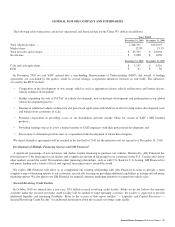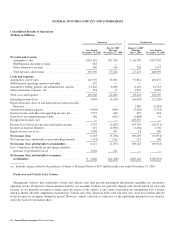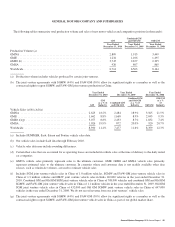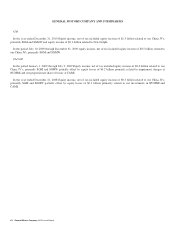General Motors 2010 Annual Report Download - page 48
Download and view the complete annual report
Please find page 48 of the 2010 General Motors annual report below. You can navigate through the pages in the report by either clicking on the pages listed below, or by using the keyword search tool below to find specific information within the annual report.-
 1
1 -
 2
2 -
 3
3 -
 4
4 -
 5
5 -
 6
6 -
 7
7 -
 8
8 -
 9
9 -
 10
10 -
 11
11 -
 12
12 -
 13
13 -
 14
14 -
 15
15 -
 16
16 -
 17
17 -
 18
18 -
 19
19 -
 20
20 -
 21
21 -
 22
22 -
 23
23 -
 24
24 -
 25
25 -
 26
26 -
 27
27 -
 28
28 -
 29
29 -
 30
30 -
 31
31 -
 32
32 -
 33
33 -
 34
34 -
 35
35 -
 36
36 -
 37
37 -
 38
38 -
 39
39 -
 40
40 -
 41
41 -
 42
42 -
 43
43 -
 44
44 -
 45
45 -
 46
46 -
 47
47 -
 48
48 -
 49
49 -
 50
50 -
 51
51 -
 52
52 -
 53
53 -
 54
54 -
 55
55 -
 56
56 -
 57
57 -
 58
58 -
 59
59 -
 60
60 -
 61
61 -
 62
62 -
 63
63 -
 64
64 -
 65
65 -
 66
66 -
 67
67 -
 68
68 -
 69
69 -
 70
70 -
 71
71 -
 72
72 -
 73
73 -
 74
74 -
 75
75 -
 76
76 -
 77
77 -
 78
78 -
 79
79 -
 80
80 -
 81
81 -
 82
82 -
 83
83 -
 84
84 -
 85
85 -
 86
86 -
 87
87 -
 88
88 -
 89
89 -
 90
90 -
 91
91 -
 92
92 -
 93
93 -
 94
94 -
 95
95 -
 96
96 -
 97
97 -
 98
98 -
 99
99 -
 100
100 -
 101
101 -
 102
102 -
 103
103 -
 104
104 -
 105
105 -
 106
106 -
 107
107 -
 108
108 -
 109
109 -
 110
110 -
 111
111 -
 112
112 -
 113
113 -
 114
114 -
 115
115 -
 116
116 -
 117
117 -
 118
118 -
 119
119 -
 120
120 -
 121
121 -
 122
122 -
 123
123 -
 124
124 -
 125
125 -
 126
126 -
 127
127 -
 128
128 -
 129
129 -
 130
130 -
 131
131 -
 132
132 -
 133
133 -
 134
134 -
 135
135 -
 136
136 -
 137
137 -
 138
138 -
 139
139 -
 140
140 -
 141
141 -
 142
142 -
 143
143 -
 144
144 -
 145
145 -
 146
146 -
 147
147 -
 148
148 -
 149
149 -
 150
150 -
 151
151 -
 152
152 -
 153
153 -
 154
154 -
 155
155 -
 156
156 -
 157
157 -
 158
158 -
 159
159 -
 160
160 -
 161
161 -
 162
162 -
 163
163 -
 164
164 -
 165
165 -
 166
166 -
 167
167 -
 168
168 -
 169
169 -
 170
170 -
 171
171 -
 172
172 -
 173
173 -
 174
174 -
 175
175 -
 176
176 -
 177
177 -
 178
178 -
 179
179 -
 180
180 -
 181
181 -
 182
182 -
 183
183 -
 184
184 -
 185
185 -
 186
186 -
 187
187 -
 188
188 -
 189
189 -
 190
190 -
 191
191 -
 192
192 -
 193
193 -
 194
194 -
 195
195 -
 196
196 -
 197
197 -
 198
198 -
 199
199 -
 200
200 -
 201
201 -
 202
202 -
 203
203 -
 204
204 -
 205
205 -
 206
206 -
 207
207 -
 208
208 -
 209
209 -
 210
210 -
 211
211 -
 212
212 -
 213
213 -
 214
214 -
 215
215 -
 216
216 -
 217
217 -
 218
218 -
 219
219 -
 220
220 -
 221
221 -
 222
222 -
 223
223 -
 224
224 -
 225
225 -
 226
226 -
 227
227 -
 228
228 -
 229
229 -
 230
230 -
 231
231 -
 232
232 -
 233
233 -
 234
234 -
 235
235 -
 236
236 -
 237
237 -
 238
238 -
 239
239 -
 240
240 -
 241
241 -
 242
242 -
 243
243 -
 244
244 -
 245
245 -
 246
246 -
 247
247 -
 248
248 -
 249
249 -
 250
250 -
 251
251 -
 252
252 -
 253
253 -
 254
254 -
 255
255 -
 256
256 -
 257
257 -
 258
258 -
 259
259 -
 260
260 -
 261
261 -
 262
262 -
 263
263 -
 264
264 -
 265
265 -
 266
266 -
 267
267 -
 268
268 -
 269
269 -
 270
270 -
 271
271 -
 272
272 -
 273
273 -
 274
274 -
 275
275 -
 276
276 -
 277
277 -
 278
278 -
 279
279 -
 280
280 -
 281
281 -
 282
282 -
 283
283 -
 284
284 -
 285
285 -
 286
286 -
 287
287 -
 288
288 -
 289
289 -
 290
290
 |
 |

GENERAL MOTORS COMPANY AND SUBSIDIARIES
Reconciliation of Consolidated, Automotive and GM Financial Segment Results
Management believes EBIT provides meaningful supplemental information regarding our automotive segments’ operating results
because it excludes amounts that management does not consider part of operating results when assessing and measuring the
operational and financial performance of the organization. Management believes these measures allow it to readily view operating
trends, perform analytical comparisons and benchmark performance between periods and among geographic regions. We believe
EBIT is useful in allowing for greater transparency of our core operations and it is therefore used by management in its financial and
operational decision-making.
While management believes that EBIT provides useful information, it is not an operating measure under U.S. GAAP, and there are
limitations associated with its use. Our calculation of EBIT may not be completely comparable to similarly titled measures of other
companies due to potential differences between companies in the method of calculation. As a result, the use of EBIT has limitations
and should not be considered in isolation from, or as a substitute for, other measures such as Net income (loss) or Net income (loss)
attributable to common stockholders. Due to these limitations, EBIT is used as a supplement to U.S. GAAP measures.
Management believes income (loss) before income taxes provides meaningful supplemental information regarding GM Financial’s
operating results. GM Financial uses a separate measure from our automotive operations because management believes interest income
and interest expense are part of operating results when assessing and measuring the operational and financial performance of the segment.
The following table summarizes the reconciliation of our automotive segments EBIT and GM Financial’s income before income
taxes to Net income (loss) attributable to stockholders (dollars in millions):
Successor Predecessor
Year Ended
December 31, 2010
July 10, 2009
Through
December 31, 2009
January 1, 2009
Through
July 9, 2009
Year Ended
December 31, 2008
Automotive
EBIT
GMNA (a) ............................ $5,748 81.4% $(4,820) 108.8% $ (11,092) 74.7% $(12,203) 85.3%
GME(a) ............................. (1,764) (25.0)% (814) 18.4% (2,815) 19.0% (2,625) 18.3%
GMIO (a) ............................ 2,262 32.0% 789 (17.8)% (486) 3.3% (555) 3.9%
GMSA (a) ............................ 818 11.6% 417 (9.4)% (454) 3.0% 1,076 (7.5)%
Total automotive EBIT .................. 7,064 100% (4,428) 100% (14,847) 100% (14,307) 100%
Corporate and eliminations (b) ............ 284 (359) 128,044 (13,000)
Interest income ........................ 465 184 183 655
Automotive interest expense ............. 1,098 694 5,428 2,525
Income tax expense (benefit) ............. 672 (1,000) (1,166) 1,766
Automotive Financing
GM Financial income before income taxes .... 129 — — —
Net income (loss) attributable to
stockholders .......................... $6,172 $(4,297) $109,118 $(30,943)
(a) Our automotive operations interest and income taxes are recorded centrally in Corporate; therefore, there are no reconciling items
for our automotive operating segments between EBIT and Net income (loss) attributable to stockholders.
(b) Includes Reorganization gains, net of $128.2 billion in the period January 1, 2009 through July 9, 2009.
46 General Motors Company 2010 Annual Report
